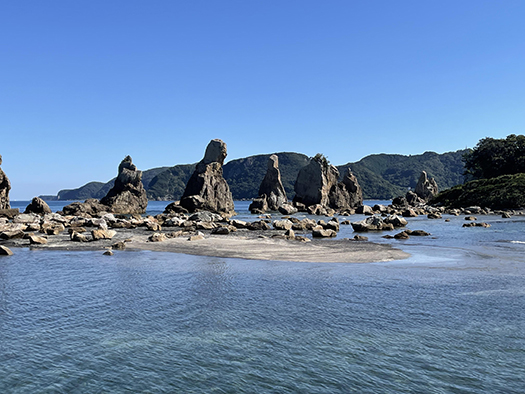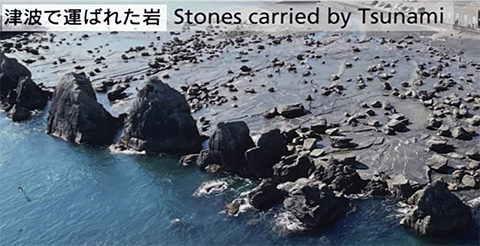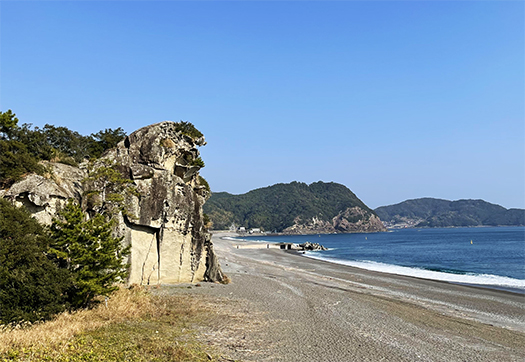


日本列島での人びとの「精神史」のなかで自然造形は、非常に大きいパーツを占めたに違いない。そういう「現場検証」的な意味合いで熊野・紀伊・南紀と歩いてみると、きのうも紹介した鬼ヶ城と比肩できる写真のようなスポットが散在している。
上の写真は紀伊大島に近い「橋杭岩」であり、3枚目は熊野の「獅子岩」。
橋杭岩の方の生成の解説を見てみると〜マグマが作った不思議な景観。幅15m長さ900mに渡って橋脚のように紀伊大島に向かってまっすぐに並んでいます。開眼に散在している岩は橋杭岩が壊れたかけら。橋杭岩から離れたところにある大岩は巨大地震による津波でここに運ばれてきたものと考えられています。〜との記述。
一方の獅子岩については〜地盤の隆起と海蝕現象によってうまれた高さ約25m、周囲約210mの奇岩です。昔から南側に位置する神仙洞の吽(うん)の岩(雌岩)に対して阿(あ)の岩(雄岩)と呼ばれ、井戸川上流に位置する大馬神社の狛犬として敬愛されていました。このため大馬神社には今も狛犬が設置されていません。〜という解説。
自然科学的な解析が未成熟な時代、古代においてこういった自然造形と出会った人びとは、あるいは修験道のような道に向かっただろうし、縄文以降、列島に定住が始まる頃にはいかにも「神奈備」の空間として、そこに八百万の神が鎮座していると考えたことは自然だと思える。
そういった精神下地の上に仏教もこの地域景観と邂逅して、独自な「涅槃」的光景としてこれらを受容して熊野三山的な神仏習合文化に至ったと観ずることができる。
日本列島は世界の中でも海と火山造形の生み出す多様性に満ちた環境であり、そこに生きた人びとの精神史はきわめて独自性の強い文化なのだと思い知らされる。
やや飛躍して考えると、こういう自然環境の中では「独裁」的な政体というのはなかなか成立させることが難しいのではないだろうか。日本の皇統始原、神武帝はこの熊野の地から大和に向かって進出して占領していくストーリーなのだけれど中国の歴世王朝のようなありようにはならなかった。
中国では「中華」というまさに暴力的独裁体制を取って、政体更新には「易姓革命」が勃発するしかなかった。中華思想という「自分たちが世界の中心である」と宣言する精神性は、周辺やほかの世界の国々からすると迷惑そのものの「押しつけ」を強い特徴として持ってしまう。そういうありようは結局強い自家中毒を起こして易姓革命を招来することになる。
日本の皇統はイギリス王家のありようとして知られる「君臨すれど統治せず」という、ある意味「民主的」な政体と類縁性の高い存在として、世界最長の歴史を刻んできた。
熊野の自然景観に親しんで行くにつれ、こういう想像を強く抱いてきております。
English version⬇
Geo-sites and Kannabis: Imperial Mythology and Kumano Journey-19
The culture of the imperial lineage approximates the “reign but do not rule” of the British royal family. A non-dictatorial regime adapted to the diverse natural environment of the volcanic archipelago. …
In the “spiritual history” of the people of the Japanese archipelago, natural formations must have been a very large part of their history. In this sense, when we walk around Kumano, Kii, and Nanki, we can find spots like the ones in the photos that can be compared to Onigajo, which I introduced yesterday.
The photo above is “Hashigaiwa” near Kii Oshima, and the third one is “Shishi-iwa” in Kumano.
The one of Hashigaiwa has an explanation of its formation: “A mysterious landscape created by magma. It is 15m wide and 900m long, and is aligned straight toward Kii Oshima Island like a bridge pier. The rocks scattered in the open eye are pieces of broken Hashikaiwa. It is believed that the large rocks that are located away from the Hashigake Iwa were carried here by the tsunami caused by a huge earthquake. 〜The description of the rock is as follows.
Shishi-iwa, on the other hand, is a strange rock with a height of about 25 meters and a circumference of about 210 meters, created by the uplift of the ground and the erosion of the sea. It has been called “A” rock (male rock) in contrast to “Un” rock (female rock) in Shinzen-do Cave located to the south, and was revered as a guardian dog of Ohma Shrine located in the upper reaches of the Ido River. For this reason, there are no guardian dogs at Ohma Shrine even today. 〜The explanation is that the rock is a “guardian dog”.
In ancient times, when natural scientific analysis was still in its infancy, people who encountered these natural formations would have gone on a path such as Shugendo, or the path of asceticism.
It is natural to assume that when Buddhism encountered the local landscape on such a spiritual foundation, it accepted it as a unique “nirvana” scene, leading to the Kumano Sanzan culture of Shinto and Buddhist syncretism.
The Japanese archipelago is one of the most diverse environments in the world, with its oceans and volcanic formations, and the spiritual history of the people who lived there is a highly unique culture.
To take a leap forward, it would be difficult to establish a “dictatorial” government in such a natural environment. The story of the origin of the Japanese imperial lineage, Emperor Jinmu, is that he advanced from Kumano to Yamato and occupied it, but it did not turn out like the Chinese dynasties of the past.
In China, the “Chinese” regime was a violent dictatorship, and the only way to renew the regime was to have the “Yi Surname Revolution” break out. The Chinese mentality of declaring “we are the center of the world” is characterized by a strong sense of “imposition,” which is annoying to the neighbors and other countries of the world. Such an attitude would eventually lead to a strong auto-addiction and bring about the Era of the Surname Revolution.
The Japanese imperial lineage has the longest history in the world as an entity closely related to the “democratic” form of government known as the “reign but do not rule,” which is in a sense the way the British royal family was known.
As I have become more familiar with the natural landscape of Kumano, I have come to strongly imagine this.
Posted on 1月 22nd, 2024 by 三木 奎吾
Filed under: 日本社会・文化研究







コメントを投稿
「※誹謗中傷や、悪意のある書き込み、営利目的などのコメントを防ぐために、投稿された全てのコメントは一時的に保留されますのでご了承ください。」
You must be logged in to post a comment.